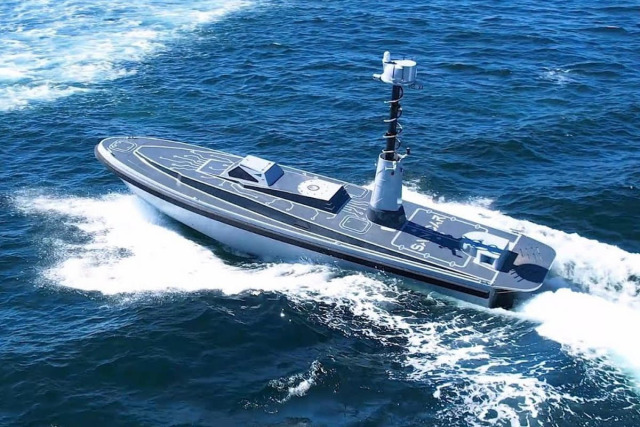As noted earlier, the industry of unmanned boats (BEC) of Turkey for military purposes has received sustainable development. The roadmap for the construction of uninhabited naval systems is balanced, has a reasoned theoretical justification and a wide range of nomenclature .
The main projects of unmanned boats for the Turkish Navy
The Albatross Project
"Albatros" (ALBATROS) is a family of uninhabited surface vehicles manufactured by Aselsan Concern. There are three products in the family: two target boats with the letters "K" and "T", as well as an autonomous experimental apparatus with advanced swarming capabilities "S".
"Albatross-K" (from catamaran) is a continuation of the family of surface targets of earlier production. It is designed to be used as a moving target for artillery firing, short-range defense systems and guided missiles of the Navy, as well as for training firing of combat aircraft.
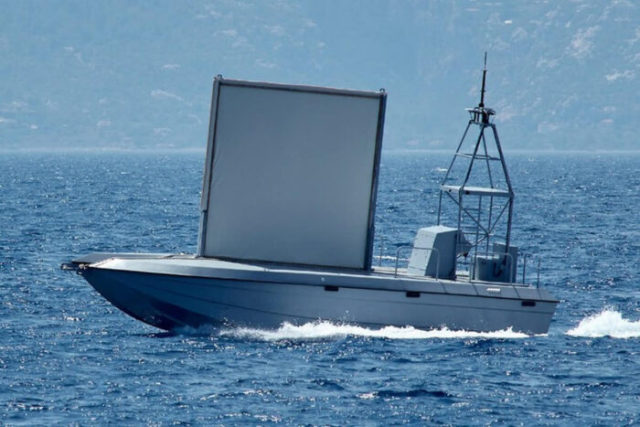
Beekipazhny boat "Albatros-K"
The product has a catamaran-type hull with a length of 10-16 m (depending on the size of the target), a width of 4.5 m, a height of up to 6 m (with a target). The gross weight varies in the range of 3-5 tons. Two diesel engines allow you to reach speeds of more than 35 knots. The range is up to 10 nautical miles, the time is up to 6 hours. As a payload, the BEC carries a target board measuring 3x3-5x5 m, a navigation camera and a hit indicator (flasher).
"Albatross-K" can be used in autonomous, semi-autonomous or remote control mode and has a user-friendly interface. According to experts, the system is an effective target simulator, which, in accordance with the tasks of exercises and shooting, allows you to implement various specified behavior scenarios.
"Albatross-T" (from Target – "target/target") is a high–speed back designed specifically for use as a moving target in shooting practice. The system allows you to remotely simulate various tactical maneuvers (for example, zigzag or direct high-speed attack) and rapid asymmetric threats. It can be used in autonomous, semi-autonomous or remote operation modes.
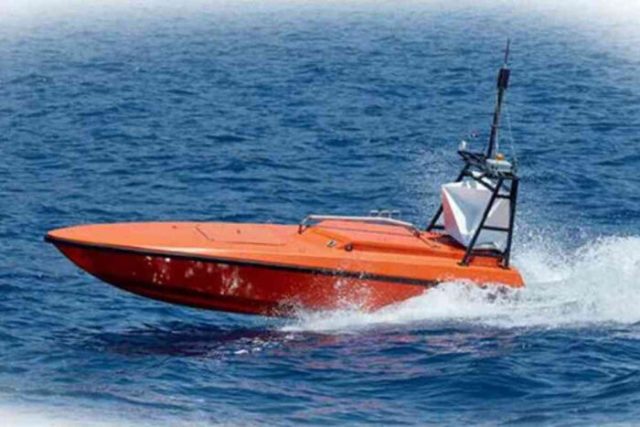
BACK "Albatross-T"
The product has a body length of 5.5 m and a width of 1.65 m. Gross weight: 950 kg. The internal diesel engine allows you to reach a maximum speed of more than 40 knots and ensures operation for 6 hours. The radius of the controlled application is 10 nautical miles.
A passive radar signal amplification reflector (corner reflector), an active radar (optional), a navigation camera, and a hit indicator are installed on the back.
Both "Albatros" and "K" and "T" can be supported by unmanned aerial vehicles manufactured by Aselsan. The image of the hit is transmitted to the control station in real time to assess damage and the quality of personnel training.
"Albatross-S" (from swarm, or "swarm") is a privately funded development aimed at implementing a domestic R&D program aimed at exploring the possibilities of unmanned swarming. These efforts are initiated by the Department of Innovative Management Systems of the Defense Industry of Turkey. The first presentation of the unmanned boat was held at the IDEF 2021 exhibition in Istanbul.
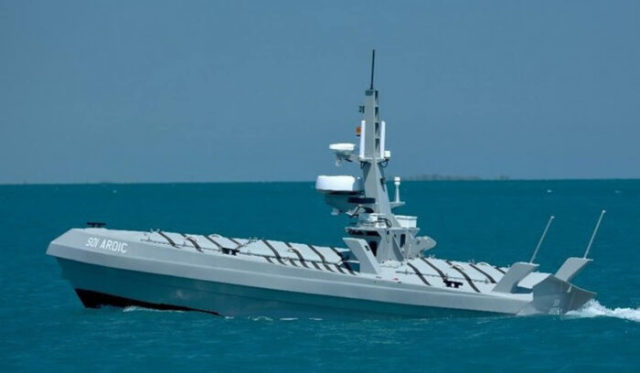
BACK "Albatross-S"
The Albatross-S uses a monocorp that is optimized to reduce radar and thermal signatures. The device has a length of 7.2 m, a width of 2 m and a displacement of about 1955 kg, including a payload weighing 250 kg. The installed diesel engine and fuel reserve provide high maneuverability, allow you to reach a maximum speed of more than 40 knots, guarantee a range of up to 200 nautical miles or continuous operation for 10 hours.
The payload includes a navigation radar, cellular radio equipment, secure satellite communications, a 4.5G/LTE communication system. According to the manufacturer, the high level of autonomy of the Albatross-S allows the BACK to operate autonomously or in a group of several unmanned platforms, interact with them and simultaneously perform complex maneuvers. The autonomy functionality includes: autonomous mission planning and distribution of tasks between swarm members, sensor fusion, detection of stationary and moving obstacles and dynamic route planning, day/night operation modes, work in conditions of communication interruption.
According to Aselsan engineers, the Albatross-S is suitable for performing a wide range of applied tasks: reconnaissance, hitting targets as a kamikaze boat, patrolling the area and protecting the port.
Salvo Project
"Salvo" (SALVO, or "salvo") is a project of the Turkish shipyard Dearsan (Tuzla), implemented jointly with such representatives of the military-industrial complex of Turkey as Aselsan, Roketsan and Yaltes. The shipyard management announced its innovation in December 2021, and in February 2022, at the DIMDEX exhibition in Qatar, it presented a line of unmanned boats under the USV-15 and USV-11 indexes. As a result, the Dearsan shipyard became the third (after Ares and Sefine) shipbuilding company in Turkey engaged in the development of uninhabited surface vehicles for military purposes.
It is stated that the Salvo BACK family will include devices with housings 15 m long (respectively, USV-15) and 11 m (USV-11). Moreover, in the latter version it is planned to have two functionally different models. The launch of the main product of the project, USV-15, took place in early 2022. The well-known and the following characteristics of the "Salvo" BEC refer specifically to this model.
According to the developer, the USV-15 will receive a wide range of capabilities and is intended for conducting reconnaissance, defeating a surface enemy, performing air defense tasks, countering asymmetric threats (including combating smuggling and drug trafficking), supporting search and rescue operations, performing coast guard and border control tasks.
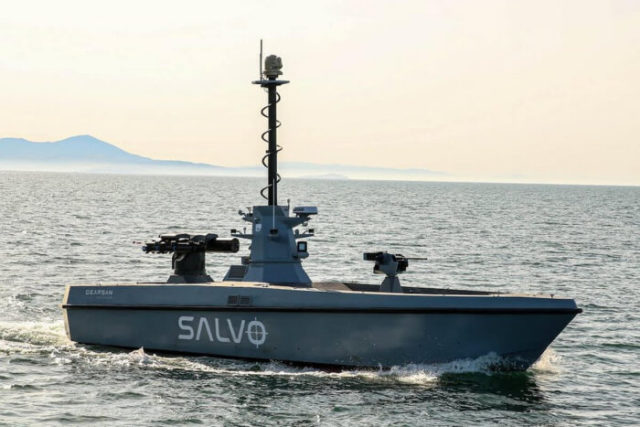
Crew-free boat of the Salvo project
The design of the device is built using the architecture of open systems. The hull is made of composite materials with a length of 14.79 m, a width of 3.83 m and a draft of 0.75 m. The Salvo power plant received two diesel engines with two water cannons and one diesel generator. It is envisaged that only one diesel engine can be installed at the request of the customer, and water cannons can be replaced with a propeller. In the USV-15 variant (depending on the type of diesel) Salvo is capable of reaching a maximum speed of 45-60 knots (83-111 km/h), while maintaining high stability. The range is up to 300 nautical miles. In the interests of optimal use of the payload, the device is equipped with a telescopic retractable MILMAST mast, which can be extended and folded during the mission.
The equipment of the device includes an autonomous control system, a navigation radar, a GPS complex, meteorological equipment, an automatic identification system, a gyroscope, an echo speaker, an electro-optical reconnaissance and surveillance system, a 4-fold circular thermal camera (360 degrees), as well as a SATCOM communication system (BLOS) and a broadband transceiver (LOS).
The Salvo armament kit includes a remotely controlled Yalman weapon station from Roketsan, which is equipped with a 12.7mm stabilized STAMP 2-L machine gun from Aselsan and a launcher of 70 mm guided missiles with laser guidance Cirit or L-Umtas missiles manufactured by Roketsan. It is reported that Roketsan is working on the integration of the Yalman weapons station with Sungur anti-aircraft missiles. It is believed that the configuration of Sungur with Yalman will provide Salvo with advanced air defense capabilities to eliminate the threats of helicopters and UAVs, and will also strengthen the defense of coastal facilities at a considerable distance from them.
The capabilities of the USV-15 for the use of weapons were demonstrated on May 25, 2022. Then the device successfully hit moving targets sequentially with a machine gun and the launch of a Cirit rocket.
According to the developers, the back of the Salvo family can be deployed from aboard large warships, in particular: landing ships-docks, frigates or corvettes. In this case, the additional involvement of the BACK will significantly increase the combat capabilities of the inhabited platform. Currently, further design of the Salvo models continues.
The Sankar Project
SANCAR is a joint development of the Yonca-Onuk shipyard (Tuzla) and the Havelsan defense Enterprise (Ankara). The work has been underway since October 2021 under a contract signed on April 8, 2022 with the Turkish Defense Industry Administration. The launch of the device took place on June 2, 2022. The first sea trials were completed in September 2022. The first presentation of the BEC "Sankar" in the form of a scale model took place in the same September, at the Waterkloof Air Base (Pretoria, South Africa), at the African Aerospace and Defense Industry Exhibition. Again, but already the prototype of the device was demonstrated in October 2022, at the SAHA EXPO exhibition in Istanbul.
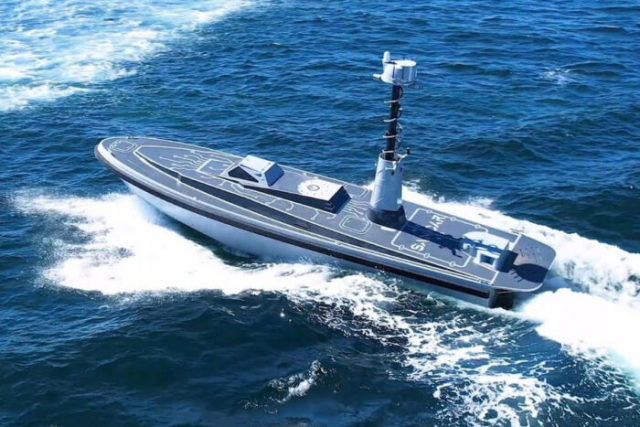
BACK of the Sankar project
The unmanned boat "Sankar" is designed for conducting reconnaissance, combating surface enemies, protecting coastal infrastructure, minesweeping and conducting search and rescue operations. Within the framework of the project, Yonca-Onuk is responsible for the design of the spacecraft body and the integration of the payload into it. Havelsan – for issues of platform autonomy, software, control systems, communication and distribution of ship data, ground control stations and interference protection.
Despite the fact that the Sankar was last demonstrated as a prototype, its design is based on a proven platform of high-speed patrol ships of the MRTP12 project, eight hulls of which were supplied by the Yonca-Onuk shipyard of the Turkish Navy. The body of the device is 12.73 m long and 3.3 m wide and has a displacement of 9 tons. Probably, a diesel power plant and a fuel reserve allow you to reach a maximum speed of up to 40 knots, provide a cruising range of 400 nautical miles and autonomy of up to 40 hours. The superstructure of the hull provides for the installation of a telescopic mast of the MILMAST type. With the mast extended, the height of the back is 12.7 m.
The modular architecture of "Sankar" allows you to build it in accordance with the requirements of the end user. According to Havelsan, autonomous technologies with embedded algorithms for combining data and artificial intelligence are used in the development of the payload for Sankar. In addition to the standard equipment for this type of products, the Sankar BEK is equipped with the Advent Rota combat control system (SBU), which is a derivative of the Advent SBU common on ships of the Turkish Navy.
In the future, thanks to its modular design, larger platforms can be built on the basis of Sankar that meet new requirements (for example, longer service life, better seaworthiness, work with stronger sea waves). As a result, the construction of the Sankar platform has a growth potential in accordance with the future requirements of the Turkish Navy.
At the time of the SAHA EXPO 2022 exhibition, the boat's armament complex included a 12.7mm stabilized STAMP-2 weapon station and two UMTAS/L-UMTAS missile launchers. The autonomy is currently being tested. The delivery of the Sankar shock tank to the Turkish Navy is scheduled for 2023.
Thus, over the past few years, the Turkish military-industrial complex has made significant progress in the construction of unmanned military boats.
According to the conclusion of Turkish analysts, despite the fact that there are industrial duplicates in the platform designs, a military-strategic consensus has formed among Turkish manufacturers of naval robotic systems. At SAHA EXPO 2022, the heads of many leading companies in the uninhabited (unmanned) systems sector agreed that the ultimate goal of their products would be the ability to work in a network-centric structure, in swarms and in fully autonomous coordination. These key terms reflect the strategic direction of the Turkish paradigm of unmanned vehicles, which, as the conflict in Ukraine has shown, can play a decisive destructive role in a naval conflict.
It is stated that currently one of the main tasks of the Turkish defense industry is to transfer the successes achieved in the field of unmanned aircraft systems to other areas of robotic warfare. Due to their capabilities in the field of reconnaissance and high-precision destruction of various types of targets, the Turkish BEC seem to be important means of supporting the Turkish government's program at sea, embodied in the geostrategic concept of the "Blue Homeland".
According to Turkish experts, in the near future there is a high probability of the appearance of a national production BEC in the waters of the Black and Aegean Seas. Given the development of the military-political situation, these regions are of the greatest concern to the Turkish leadership. The combination of the back, UAVs and the rapidly growing capabilities of anti-ship missiles will significantly increase the combat potential of the Turkish Navy, guaranteeing an acceptable level of stability at sea.
At the same time, as a permanent member of NATO, Turkey is responsible for its eastern flank. Building up the country's operational capabilities through the development of robotic systems increases the value of the Turkish Navy within the alliance and allows us to count on almost equal participation in the development of modern scenarios of war at sea, implemented on the scale of the bloc.
In addition, the presented projects of uninhabited naval systems of Turkey have already entered the international arms market. It is obvious that they have a significant export potential. Consequently, along with the prospects of economic benefits, Ankara receives an additional tool for spreading its influence in the world.
According to the materials of the resource edam.org.tr
